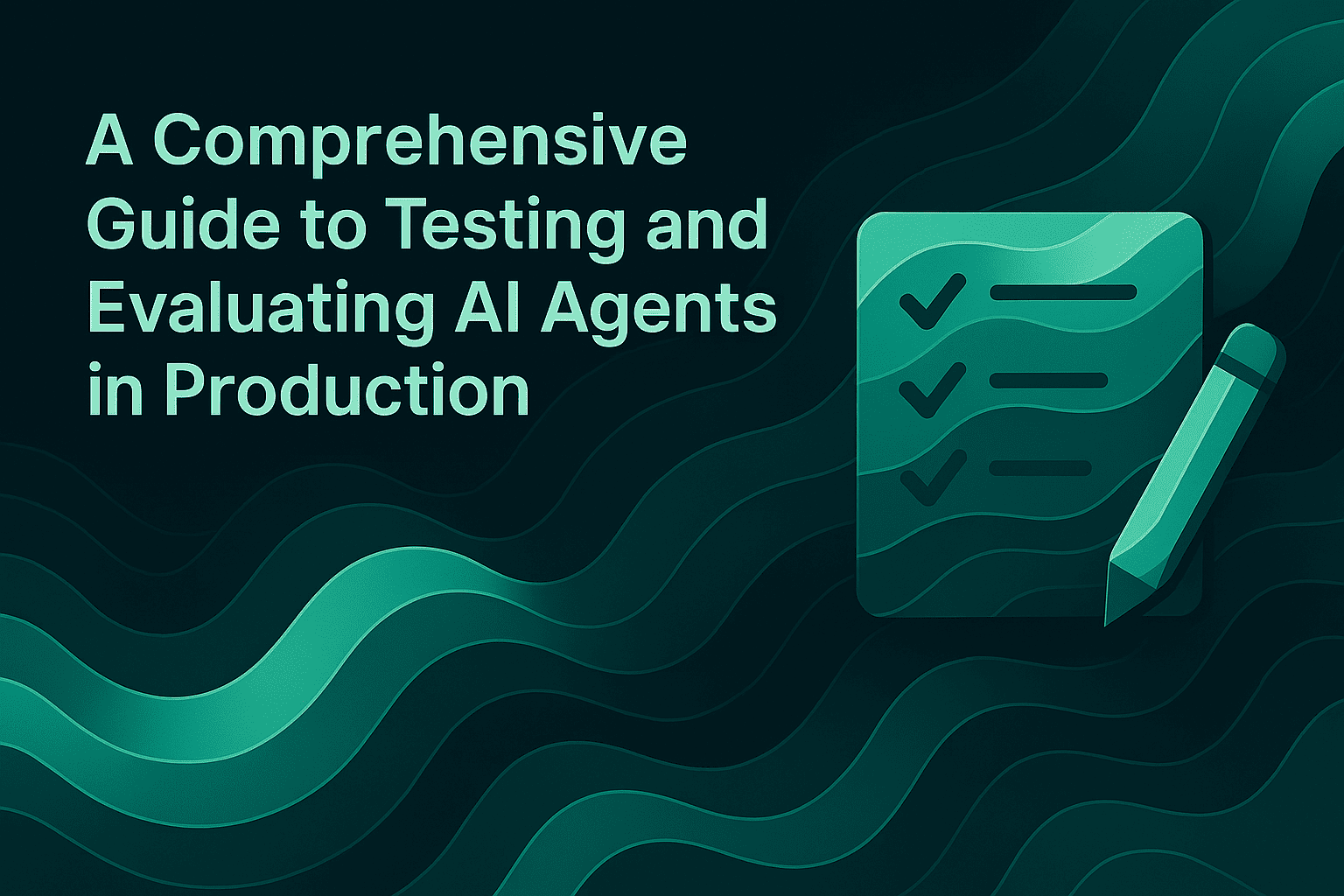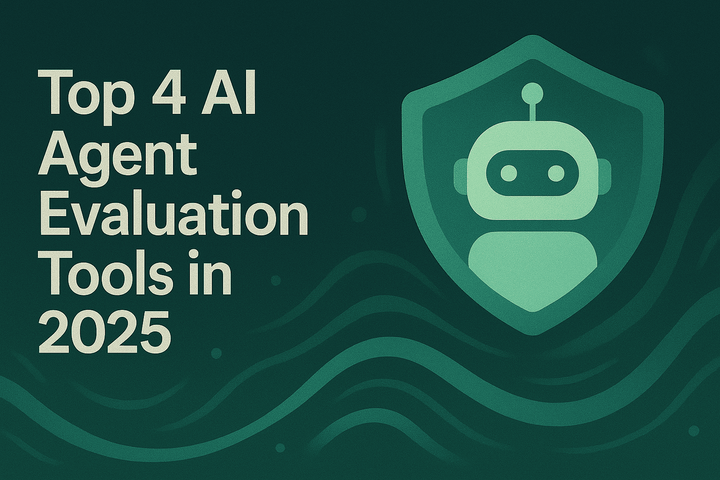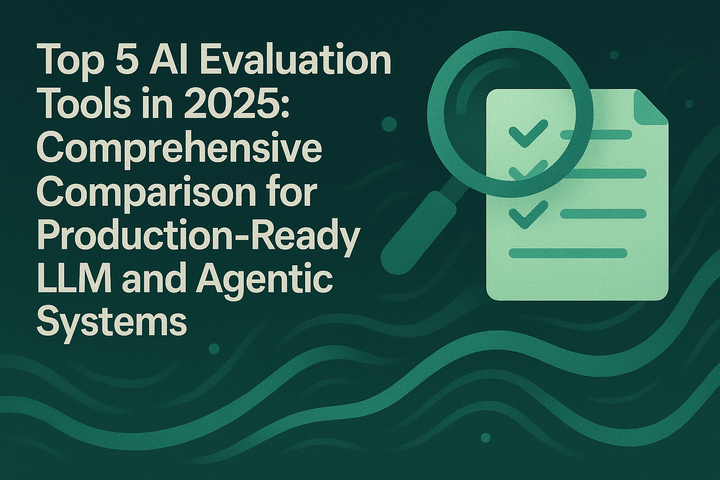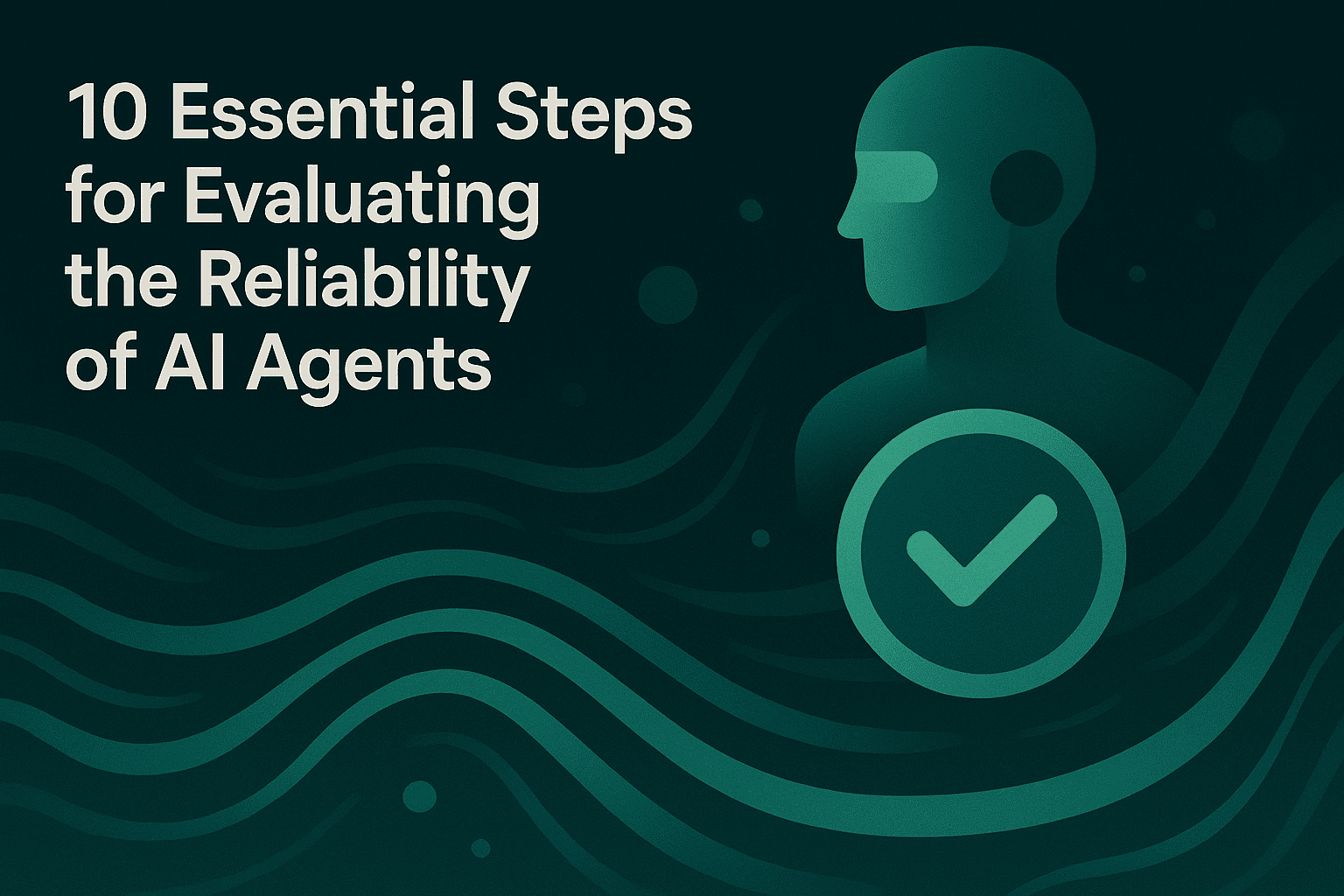A Comprehensive Guide to Testing and Evaluating AI Agents in Production

TL;DR
Testing and evaluating AI agents in production requires a systematic approach that combines pre-deployment validation, continuous monitoring, and iterative improvement. This guide covers essential strategies including simulation-based testing, multi-layered evaluation frameworks, real-time observability practices, and data curation techniques. Organizations can achieve reliable AI agent deployments by implementing comprehensive testing methodologies across the entire AI lifecycle from experimentation through production monitoring while maintaining quality standards through both automated and human evaluation processes.
Understanding the AI Agent Testing Landscape
AI agents represent a paradigm shift from traditional software systems. Unlike conventional applications with deterministic behavior, AI agents exhibit probabilistic outputs that vary based on context, user inputs, and model parameters. According to research from Stanford's AI Index, production AI systems face unique challenges including hallucinations, context drift, and inconsistent reasoning that traditional testing methods cannot adequately address.
The complexity of testing AI agents stems from several factors. First, agents operate across multiple interaction turns, maintaining conversational context and executing multi-step workflows. Second, they integrate with external tools, databases, and APIs, creating numerous potential failure points. Third, their performance depends on prompt engineering, model selection, and retrieval mechanisms that require specialized evaluation approaches.
Organizations deploying AI agents must adopt a comprehensive testing strategy that addresses these challenges. Research published in the Journal of Machine Learning Research indicates that companies implementing structured evaluation frameworks experience 60% fewer production incidents compared to those relying solely on ad-hoc testing methods. This underscores the critical importance of systematic agent evaluation.
The testing landscape encompasses three primary dimensions: pre-deployment validation through simulation, runtime quality assurance through observability, and continuous improvement through data-driven iteration. Each dimension requires distinct methodologies and tooling approaches to ensure agent reliability.
Building Robust Pre-Deployment Testing Frameworks
Pre-deployment testing establishes the foundation for reliable AI agent performance. This phase involves rigorous validation before agents interact with end users, utilizing simulation environments that replicate real-world conditions without production risks.
Simulation-Based Testing Strategies
AI-powered simulations enable teams to test agents across hundreds of scenarios and user personas systematically. Simulation environments should recreate diverse conversational contexts, edge cases, and failure modes that agents might encounter. Studies from Google's AI research team demonstrate that simulation-based testing identifies 85% of critical issues before production deployment.
Effective simulation requires creating realistic user personas that represent actual customer behavior patterns. These personas should vary in technical expertise, communication styles, and intent complexity. Agents must demonstrate consistent performance across this spectrum to ensure production readiness.
Teams should design scenario libraries covering happy paths, edge cases, and adversarial inputs. Each scenario tests specific agent capabilities: task completion rates, multi-turn coherence, tool usage accuracy, and error recovery mechanisms. Agent simulation platforms allow teams to monitor how agents respond at every conversational step and identify failure points before users experience them.
Multi-Layered Evaluation Frameworks
Comprehensive agent testing requires multiple evaluation layers operating in concert. The evaluation framework should combine automated metrics, programmatic checks, statistical analysis, and human judgment to capture agent quality holistically.
Automated evaluators assess fundamental agent capabilities including response relevance, factual accuracy, instruction following, and safety compliance. Research from Anthropic's alignment team shows that LLM-as-a-judge evaluation methods correlate strongly with human preferences when properly calibrated with domain-specific criteria.
Programmatic evaluators verify deterministic requirements such as output formatting, API response codes, and data structure validity. These checks ensure agents maintain technical specifications across all interactions. Statistical evaluators track performance distributions, detecting anomalies and regression patterns that indicate quality degradation.
Human evaluation remains essential for nuanced quality assessment. Human reviewers evaluate subjective dimensions including tone appropriateness, contextual understanding, and user experience quality that automated methods struggle to capture accurately. Organizations should implement structured human review workflows with clear evaluation criteria and inter-annotator agreement tracking.
Prompt Engineering and Optimization
Agent behavior fundamentally depends on prompt engineering quality. Testing frameworks must evaluate how prompt variations affect agent performance across different scenarios. Advanced prompt engineering tools enable rapid iteration, allowing teams to compare output quality, cost, and latency across prompt variations.
Prompt testing should examine multiple dimensions: instruction clarity, context window utilization, few-shot example quality, and constraint specification. Teams need systematic methods for versioning prompts, deploying variations with experimentation strategies, and measuring their impact on agent behavior.
Research published in the ACM Conference on Fairness, Accountability, and Transparency highlights that systematic prompt optimization reduces hallucination rates by up to 40% compared to ad-hoc approaches. Organizations should implement prompt management workflows that track versions, associate prompts with evaluation results, and enable controlled rollout of prompt updates.
Implementing Continuous Production Monitoring
Pre-deployment testing provides initial validation, but production environments introduce complexities that simulation cannot fully replicate. Continuous monitoring ensures agents maintain quality standards as they encounter real user interactions, evolving contexts, and system integrations.
Real-Time Observability Infrastructure
Production observability requires comprehensive instrumentation capturing agent behavior at multiple granularity levels. Distributed tracing tracks requests through multi-agent systems, revealing bottlenecks, failures, and performance degradation patterns.
Observability infrastructure should capture structured logs containing user inputs, agent outputs, intermediate reasoning steps, tool invocations, and system metadata. This telemetry enables root cause analysis when agents behave unexpectedly. According to research from the Conference on Neural Information Processing Systems, organizations with mature observability practices resolve production incidents 70% faster than those relying on basic logging.
Teams need real-time alerting mechanisms that trigger when agents exhibit problematic patterns: elevated error rates, latency spikes, safety violations, or task completion failures. Alert configurations should balance sensitivity and specificity to avoid alert fatigue while ensuring critical issues receive immediate attention.
Observability platforms should support creating multiple repositories for different applications, enabling teams to log and analyze production data using distributed tracing methods. This organizational structure facilitates focused debugging and prevents cross-application interference during incident response.
In-Production Quality Evaluation
Production monitoring extends beyond infrastructure metrics to include automated quality evaluation of live agent interactions. Teams should implement periodic quality checks that assess real user conversations against established standards.
Automated evaluations running on production logs detect quality regressions before they significantly impact user experience. These evaluations should leverage custom rules tailored to specific application requirements, measuring dimensions including response accuracy, safety compliance, and brand alignment.
Production evaluation pipelines must operate efficiently at scale, processing high-volume interaction data without introducing latency. Research from Meta's AI research division demonstrates that streaming evaluation architectures can assess production quality with sub-second latency while maintaining evaluation accuracy comparable to batch processing methods.
Organizations should establish quality baselines during initial deployment and continuously monitor for deviations. Statistical process control methods identify when production quality trends outside acceptable ranges, triggering investigation and remediation workflows.
Debugging and Root Cause Analysis
When production issues arise, teams need efficient debugging workflows that minimize mean time to resolution. Agent debugging requires tracing individual interactions through complex system architectures to identify failure points.
Debugging tools should provide conversation replay capabilities, allowing engineers to reproduce issues and test potential fixes. Visualization of agent reasoning chains, tool invocations, and decision points helps teams understand why agents behaved unexpectedly in specific contexts.
Effective debugging requires correlating multiple data sources: agent logs, system metrics, user feedback, and evaluation results. Unified platforms that aggregate these signals reduce cognitive overhead and accelerate root cause identification. Organizations should implement debugging runbooks that document common failure patterns and resolution procedures to standardize incident response.
Data-Driven Continuous Improvement
Testing and evaluation generate valuable data that should inform iterative agent improvement. Organizations that systematically leverage evaluation insights achieve faster quality improvements and more reliable deployments.
Data Curation and Management
High-quality datasets form the foundation for effective agent development and evaluation. Teams need robust data management workflows that continuously curate multi-modal datasets from production interactions, evaluation results, and human feedback.
Data curation should prioritize diverse, representative samples covering the full range of agent capabilities and use cases. Research from the International Conference on Machine Learning indicates that curated datasets with balanced distribution across difficulty levels and interaction types yield more reliable evaluation results than randomly sampled production data.
Organizations should implement systematic processes for importing datasets, enriching data through human annotation, and creating data splits for targeted evaluations. Data lineage tracking ensures teams understand dataset provenance and can reproduce evaluation results across different development cycles.
Feedback Integration and Learning Loops
User feedback provides critical signals about agent performance that automated metrics cannot capture. Teams should implement structured feedback collection mechanisms including explicit ratings, implicit behavioral signals, and qualitative comments.
Feedback integration workflows should route user reports to appropriate stakeholders: product teams for feature requests, engineering teams for bugs, and operations teams for urgent issues. Organizations need closed-loop systems that track feedback from collection through resolution, measuring how quickly teams address user concerns.
Research published in the Journal of Artificial Intelligence Research demonstrates that organizations incorporating user feedback into weekly evaluation cycles achieve 45% higher user satisfaction scores compared to those with monthly or quarterly feedback integration cadences.
Model and Prompt Iteration Strategies
Evaluation insights should directly inform model selection and prompt optimization decisions. Teams need systematic approaches for testing alternative models, comparing performance across evaluation dimensions, and making data-driven deployment decisions.
Experimentation platforms enable controlled comparison of model alternatives, measuring how different models perform across quality, cost, and latency metrics. Organizations should implement A/B testing frameworks that deploy model variations to production subsets, collecting real-world performance data before full rollout.
Prompt iteration should follow similar systematic approaches. Teams should maintain prompt versioning systems, associate prompts with evaluation results, and analyze how prompt changes affect agent behavior across diverse scenarios. Statistical rigor in prompt experimentation prevents premature optimization based on limited data.
Establishing Cross-Functional Collaboration
Successful AI agent testing requires collaboration across engineering, product, quality assurance, and operations teams. Organizations must establish workflows that enable these groups to contribute effectively to agent quality.
Bridging Technical and Non-Technical Stakeholders
AI quality initiatives often fail when confined to engineering teams. Product managers need visibility into agent behavior to make informed roadmap decisions. Quality assurance teams require tools for conducting systematic testing without deep technical expertise. Customer support teams need mechanisms for reporting issues and tracking resolutions.
Platforms supporting cross-functional collaboration enable product teams to configure evaluations, create dashboards, and analyze agent behavior without code. This democratization of AI quality tools accelerates development cycles and ensures diverse perspectives inform agent optimization.
Organizations should establish shared metrics that different stakeholders understand and value. While engineering teams focus on technical metrics like latency and error rates, product teams prioritize business metrics like task completion and user satisfaction. Quality frameworks should connect these perspectives, demonstrating how technical improvements drive business outcomes.
Governance and Compliance
Production AI agents must comply with regulatory requirements, organizational policies, and ethical guidelines. Testing frameworks should incorporate compliance checks that verify agents meet these standards before and during deployment.
Governance mechanisms should track agent usage, enforce rate limiting, and implement access control to prevent misuse. Research from the AI Now Institute highlights that organizations with formalized AI governance frameworks experience 55% fewer compliance incidents compared to those without structured governance approaches.
Teams should implement budget management systems that control AI costs across teams, projects, and customers. Hierarchical cost controls prevent budget overruns while maintaining development velocity. Documentation standards ensure teams maintain records of agent behavior, evaluation results, and deployment decisions for audit purposes.
Conclusion
Testing and evaluating AI agents in production requires comprehensive strategies spanning pre-deployment validation, continuous monitoring, and iterative improvement. Organizations that implement systematic testing frameworks, leverage multi-layered evaluation approaches, and maintain robust observability infrastructure achieve significantly more reliable agent deployments.
The key to successful AI agent testing lies in combining automated evaluation methods with human judgment, integrating evaluation throughout the AI lifecycle rather than treating it as an afterthought, and fostering cross-functional collaboration that ensures diverse stakeholders contribute to agent quality. As AI agents become increasingly sophisticated and handle more critical functions, rigorous testing methodologies transition from competitive advantages to operational necessities.
Organizations seeking to accelerate their AI agent development while maintaining quality standards should evaluate platforms that provide end-to-end support for simulation, evaluation, and observability. Maxim AI offers comprehensive tools that enable teams to ship AI agents reliably and more than 5x faster through integrated experimentation, evaluation, and monitoring capabilities.
Ready to implement robust testing for your AI agents? Schedule a demo to see how Maxim AI can help you ship reliable AI applications faster, or sign up today to start evaluating your agents with confidence.


